1940s
“It is understood that Longobardi has been called up for military service.” That is the result
of the 1940’s Men’s Open Doubles.
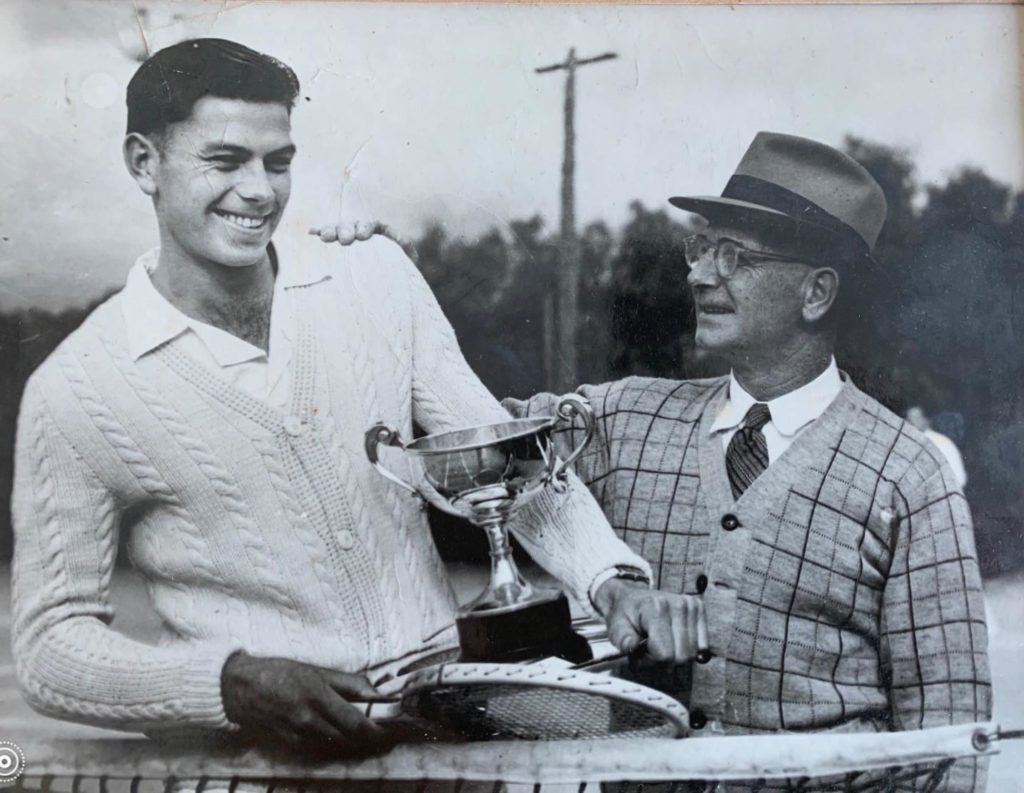
The Men’s Singles continue to be the principle event of the tournament, and large numbers of spectators were the norm. There were no tournaments in 1942-3-4 due to the war, and in 1945 the Griffith Tennis Club wanted to have lawn courts between Canal and Ulong street, obviously it didn’t happen.
In 1945 the local paper named all the visiting players, the number of courts (10) and events
(11). Miss Esme Ashford, a State player from Scone who was working for the Land Army
together with her sister cleaned up most events in 1945-6-7. Esme between 1947-52 was ranked in the top 5-10 female Australian players.
During this decade if rain stopped play or events weren’t completed, the competitors came back the next weekend (or 2). It did mean that some of the championships were
“walkovers” as the out-of-town players just couldn’t get back.
In 1947 some of the participants were in the Victorian interstate team, A grade pennant
players from Melbourne and “prominent Juniors,” plus those from Sydney. They played in 5 championship, 4 special, 2 junior and 3 handicap events. Courts from the Jondaryan and Soldiers Club were also used.
In 1948 (when the inter-town competition had just started) an article in the Area News
commenting on the Cregan Cup tennis match at Griffith last weekend “Double Fault” in the Narrandera Argus says “a sensation was caused early in the singles, when our champ Reg Crowe, was soundly defeated by W. Mackay 6/0, 6/1. I thought Reg was practically unbeatable in the county, but Bill Mackay is indeed an “ace” player, and must now be considered the singles champion of the south-west.”
In 1949 Bill Mackay won the singles for the third time and got to keep the MIA cup. Miss
Beryl Penrose (Australian Junior Champion) won the Women’s Singles final without losing a game, then also won the doubles and mixed as well.
As usual “elaborate arrangements were made for the entertainment of the visitors on
Saturday night at a dance in the Memorial Hall.”
1950s
The 1950s was a time of change for the Griffith Tennis Club. With the lease from the
Irrigation Commission expiring the club battled to keep the courts at the Banna Avenue site, with petitions and even delegations to Sydney. However this was not to be, the site sold for 76,000 pounds in 1955 and the club moved to the current location at Jubilee Park.
In 1950 Rex Hartwig won all events, and went on to be in the Davis Cup team and win
doubles at Wimbledon in 1954. Local player Aileen Savage claimed the singles
championship.
The 1951 tournament was a long, drawn-out affair with results not finalised till mid-July.
However “a beautiful collection of trophies has been secured for the occasion,” which Bill Mackay collected as his “play was outstanding in the finals in which he played—the Open Singles, the Men’s Doubles and the Mixed Doubles.”
The first program/entry form that the club possesses is from 1953- a year when the
tournament was in October! The dance on Saturday night features prominently on the front of the form (and there is a description of the evening among the results). Bill Mackay missed out, being defeated by Sydney players in the singles and doubles.
In 1955 the tournament was played at the new venue. However rain on the Monday
afternoon caused some results to be decided on the toss of a coin, others were played later.
Tom Condon remembered “a downpour on the new soft courts at the end of the 1955
tournament resulted in a memorable men’s doubles semi-final. Locals Bill Mackay and Nev Boland played barefoot against their Temora opponents with the ball splashing muddy water into their faces.”
An article in the paper in 1957 describes how special and special handicap events exclude top ranked players. The men’s doubles was the outstanding match of the tournament. Bill Mackay and Terry Meakin of Griffith played excellent tennis to break through and defeat Cyril Longworth of Griffith and Brue Podmore of Temora after being one set-all, and 10-all in the third set.
And in 1958 the “most popular win of the tournament was the victory of Norma Farrell in the ladies singles championship. In what was a match of service breaks, Norma played well controlled tennis to eventually wear down Mrs. Norton after a long struggle 10/8, 6/2. She also won the doubles and played in the semi-final of the mixed”
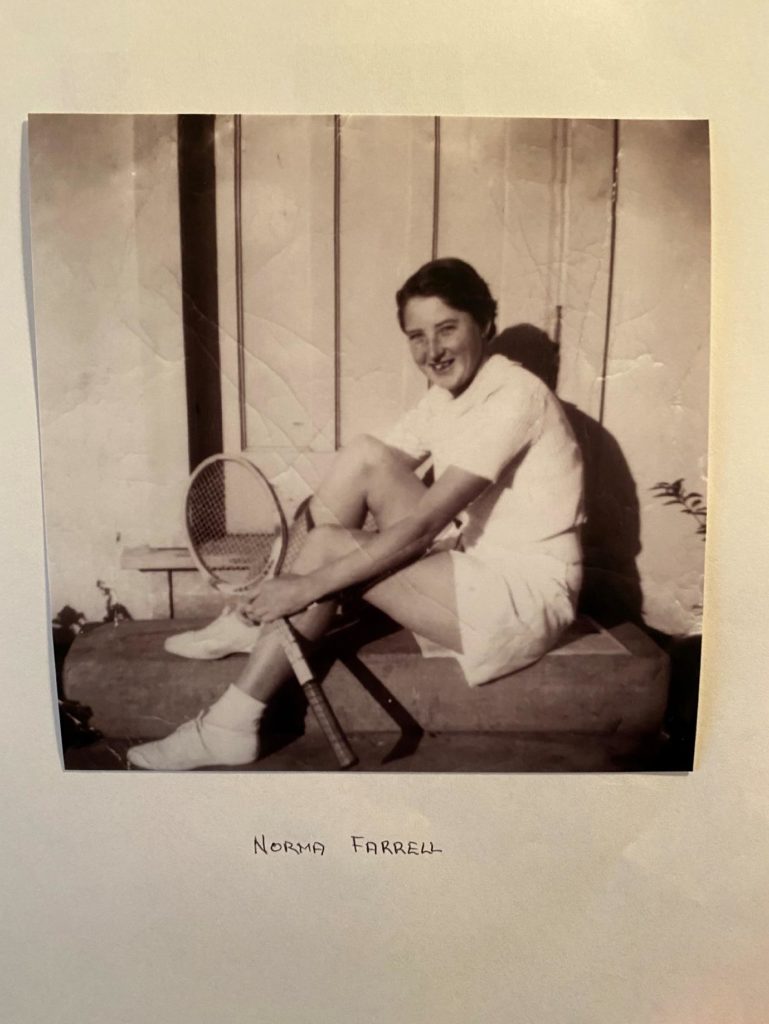
1960s
In 1960 Norma Gee (nee Farrell) won the singles championship for the third consecutive year, and as such got to keep the “Gibbons Cup.”
Unfortunately there is little further information available for this decade.
Apparently Hoad Sedgman had visited in 1962 and there were ball-boys for the major events.
In 1966 Doug Kelso form Newcastle won the singles title, he had competed at Wimbledon the previous year.
In 1967 “some very fine performances were put up during the tournament.” For the first time since 1954, when Bill Mackay won the singles title, that a Griffith competitor had reached the final of the singles. This was Trevor Hornery who was beaten by John Gardner. John was from Temora and won the junior boys, men’s open singles, open mixed and was runner-up in the doubles.
Helen Crozier from Ganmain won the junior girls, open ladies singles and open ladies doubles.
When Trevor Hornery did win the open men’s singles in 1969, it did not rate a mention in the newspaper. The tennis article was about Helen Crozier having won the singles and doubles for three years running as a 13-, 14- & 15-year-old. She also had junior and open mixed titles as well.
1970s
In the 1970s the number of events increased from 24 to 28 as younger junior events became more popular.
1972 saw the Luff ladies from Gundagai have a very successful tournament and “all played excellent tennis.” Frances Luff won the Open Singles final, and also won the Open Ladies Doubles with her mother. Mrs Luff had won the Doubles in 1952, and also won the Special Ladies Doubles with her younger daughter Sue.
In 1973 rain prevented any play on the Saturday and only a few courts were playable on the Sunday and Monday, even these were very heavy. Bitumen and concrete courts around the district were used extensively over the weekend. Most matches were shortened, and some completely omitted. Four out of the five Championships were able to be decided.
In 1975 the local paper reported that the strong Canberra players should have an interesting clash with the Melbourne group of players. However apart from the Men’s Singles, Frances Luff and the locals won the other Championship titles. Luff (who was the Australian No 8 seed at the time) also became the permanent holder of the Nora Gibbons trophy as she had won the singles for the third time.
In 1977 the tennis was played in perfect weather with the courts playing very freely, players playing their best, providing spectators with a standard of play that has rarely been reached in many years. However, the next year was so wet it was called off on the Monday morning. There was some play on Sunday and “a scratch pair, 64year old Albert Jacoby and John Corcoran (Parkes) lost a cliff-hanger to fiery tempered Melbourne pair, Bateman and Walker, 5/7, 7/6, and 6/4.” It must have been an interesting match! In the end, all matches except Championship events were decided on a toss of a 50cent coin. Players remaining in the Championships had the prize money distributed evenly.
Steve Longworth started managing the tournament, no computers then!!
By 1979 technology caught up with the Griffith tennis community. MTN 9 filmed highlights of the tennis and then telecast them each evening. Ball boys and girls had been trained up for the occasion to handle the main matches. There was a long description of the Men’s Singles final in which Brett Edwards the 18yr old had an enthralling final against the proven Ken Wurtz of Albury.
1980s
The continued sponsorship of the MIA tournament by the Caltex suppliers/service stations and then Sunwhite Rice ensured the numbers of player entering the tournament remained high and increased.
The highlight of the 1981 tournament was to be the presence of Australia’s most promising juniors – members of the John Newcombe & Tony Roche squad doing battle with Griffith’s state-age champions Des Tyson, Daryl Henderson, Lyn Andreazza, Margo Dickson and Helen Whiteside. “It is unlikely that Griffith will ever see a more talented group of juniors play tennis in the town.” Albury and Griffith players came out on top. The same players dominated again in 1982 except for the men’s singles.
Steve Longworth used CAT computer software for the first time in 1981 or 1982, then print draws in 1984. Coverage by Television station MTN 9 increased the profile of the sport.
In 1983 Steve Maloney (ACT) record run of wins commenced. “Steve Maloney’s 6-1, 6-0 final against Sydney’s Paul Toohey was one of the easiest final victories ever.”
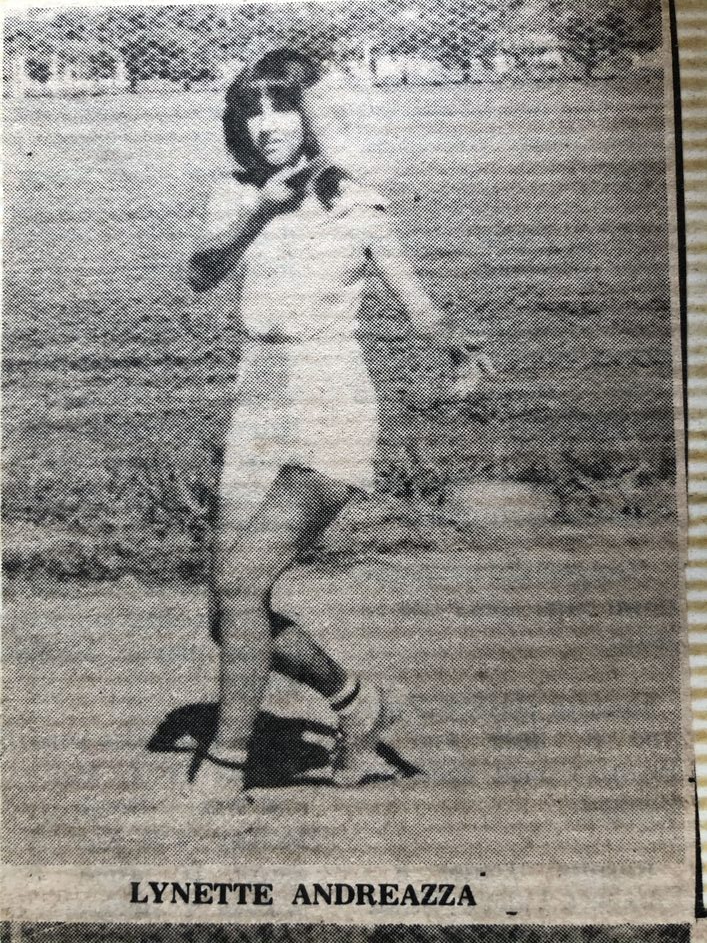
Lynette Andreazza (Griffith) – 3 times Open Women’s Champion 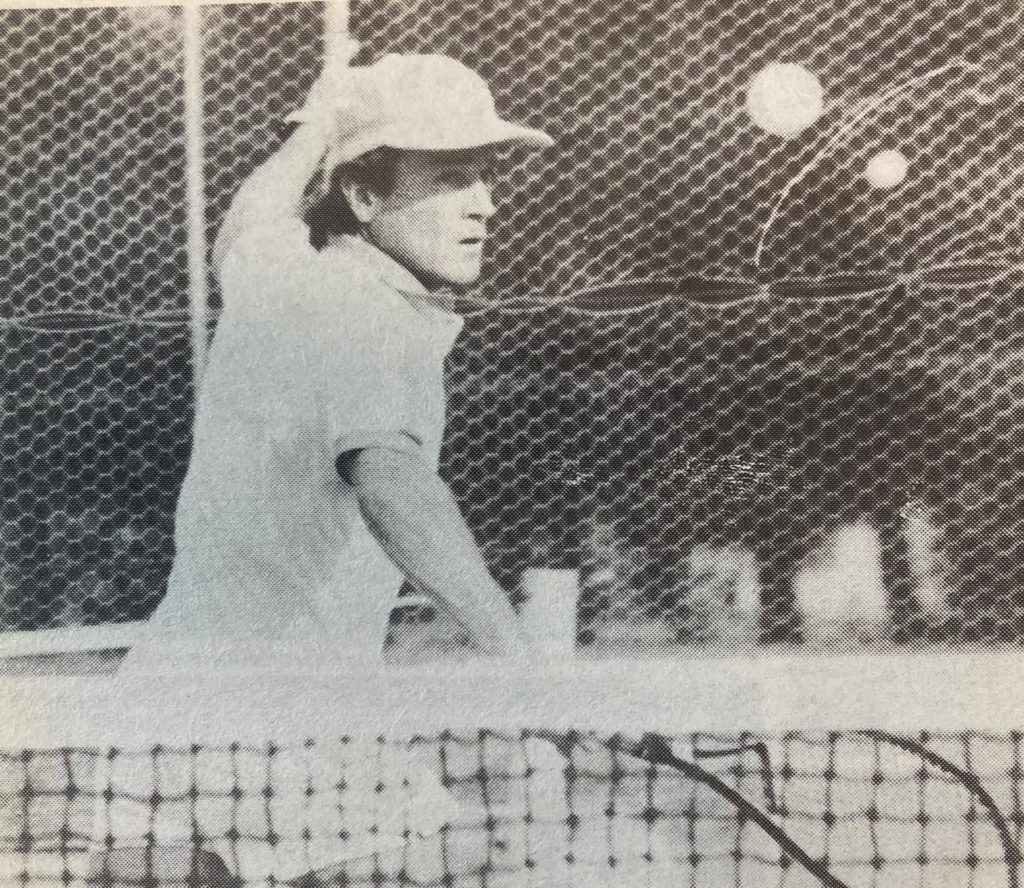
Steve Maloney (ACT) – 5 times Open Men’s Champion
Lynette Andreazza didn’t lose a game on the way to winning the singles championship, and as she had won this event three times (in similar fashion) was awarded the Nora Gibbons Trophy permanently. The other strong female juniors won the women’s doubles twice.
In 1984 Des Tyson returned to town as an 18year old to contest the MIA singles championship. He had a national ranking of 3 in the U18s and 29 in Australia. He played Steve Maloney in the final. “Steve used a great array of spin and depth and never allowed Tyson to settle into a pattern. Maloney is extremely fast about the court and an outstanding tactician. He read Tyson’s shots early, showed fine touch and made very few errors.” Tyson did however get his revenge in the doubles. Lyn Andreazza continued on her merry way winning all three championships. This was the last time she played this tournament.
Steve Maloney continued to win the MIA Championship until 1988, his “strength is his great adaptably, varying his game to the one most effective against his opponent.” He also won five doubles titles with a variety of partners. Daryl Henderson from Griffith won the mixed doubles in 1985 & 1988 and was runner up in the men’s doubles four times.
Louise Hornery got a write up when at 14 she was runner-up in the women’s doubles. She had also performed well in other events.
From 1988 the tournament featured a computer time draw which enabled players and spectators to see the days’ schedule for each player. Players were always challenged by the different surfaces, loam, artificial grass, from damp & slow to warm & fast, and because of the numbers of entries in 1989, the Yenda tennis club made its four courts available for use.
Steve Maloney was unavailable to play in 1989, so ended his amazing run. Jason Clifford did well coming runner-up in the men’s doubles, “both combinations displayed brilliant reflexes at the net and produced some fine volleys.”
Louise Pleming (Wagga) had her third win in the singles in 1989, but as these were not sequential, she wasn’t eligible for the permanent awarding of the Nora Gibbons trophy.
1990s
In 1990 Ken Wurtz (Albury) won the men’s singles again ten years between drinks. Terry Smith (Bendigo) won in 1991, to “take nothing away from the winner, he had too much consistency and made less mistakes than his opponent” in Steve Maloney. Terry added his Griffith title to the Australian Veterans Championship he had won earlier that year. Griffith’s Jason Clifford and Laurie Pappalardo were unable to defend their men’s doubles title losing in the final.

Ken Wurtz (Albury) 1990 Open Men’s Champion 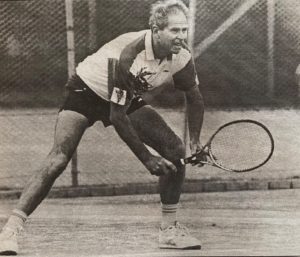
Terry Smith (Bendigo) 1991 Open Men’s Champion
In 1992 “7-year-old Danny Dossetor showed plenty of promise, finishing runner-up in the U10 boys and making the semi-final for the 12yrs doubles.” Mark Henderson was also doing well in the juniors. (see the cute photo at end of folder)
By 1993 the tennis club had named each event after a sponsor, the father/son and mother/daughter events were up and running and proving VERY popular. Noel Hicks, the Federal Member for Riverina presented the prizes, and for the first time in nine years a Griffith lady had won a Championship event, the open women’s doubles. Donna Dossetor teamed with Anne Lewington, the winner of the women’s open singles, to win “in a marathon three set match 5-7, 7-5, 7-6.” However it was the very secretive team of “Laverne and Shirley” from Griffith who caused a stir. The pair, who would not give their first names, had a successful weekend with several finals appearances. They won the B Grade women’s doubles, and also mixed and veteran events. Was the local coach involved in this??

Glenn Jennings (Leeton) 1996 Open Men’s Champion 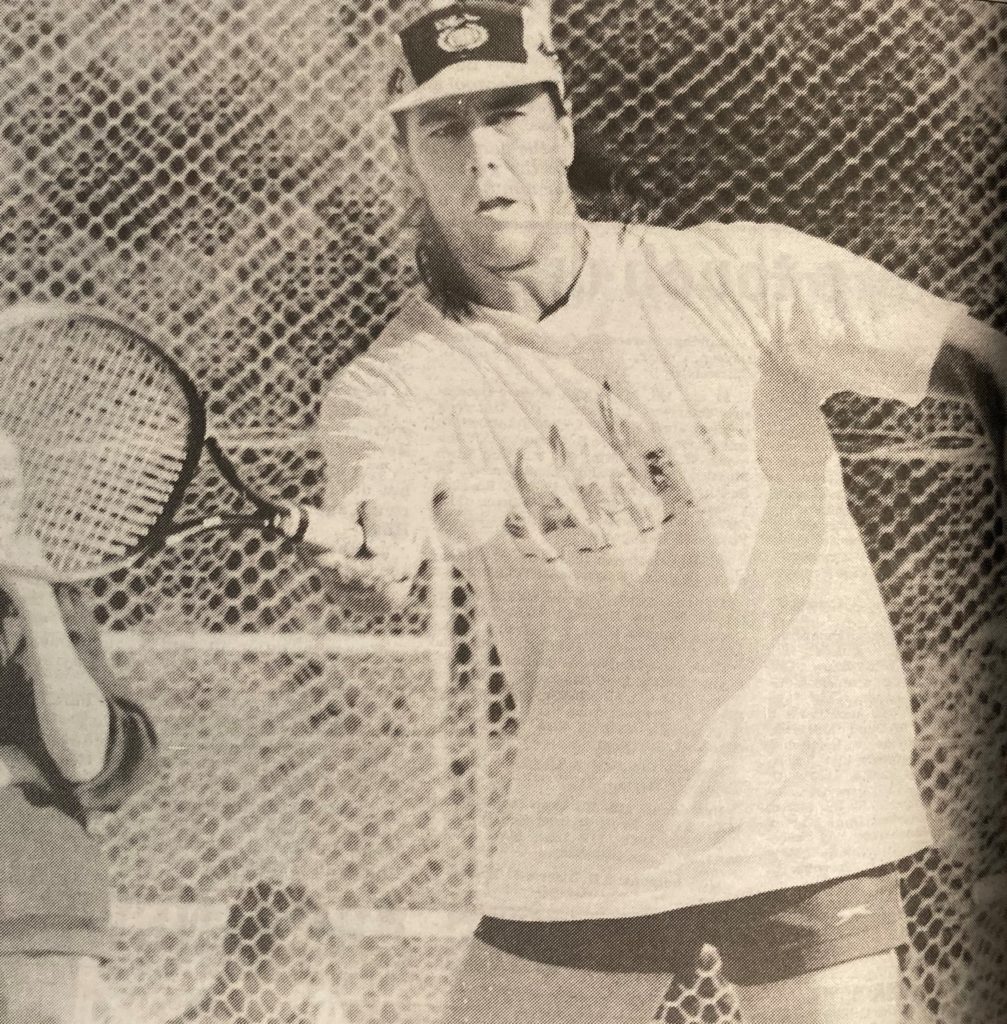
Chris Raftery
1996 was exciting for the Griffith district as 17 year old Glenn Jennings from Leeton won the men’s open singles, beating the Bendigo veteran Terry Smith 6-3, 6-3. Glenn “dominated throughout particularly in baseline play where his deep drives kept Smith away for the net. Smith has been finalist on each of his five visits here.” It was also a milestone for local junior Jason Clifford, defeating his former coach Roman Adamcewicz in the singles, however he was then defeated by Smith in the next round.
NOW is the time to give credit to the coaches who have bought car/bus loads of players/juniors to this tournament for decades and shown their charges how to win tournaments by example. I speak for Roman Adamcewicz, Phil Shanahan and Terry Smith in particular.
In 1999 Orange juniors Paul Telford and Nicole Bouffer swept all before them. Paul defeated local Mark Henderson to win the open singles in two closely fought sets, the first set was 6-4, but the second set was much closer and was forced to a tie-breaker, however Henderson was unable to level the game with Telford taking the set 7-6 in an entertaining final. Nicole Bouffer also won the women’s doubles with local Angela Dossetor, then the two Orange players defeated Danny and Angela Dossetor 7-4 in the open mixed final.
2000s
In 2000 Steve Longworth was able to publish draws, players times and results on-line. On line entries commenced in the mid 1980’s. No wonder he was called a magician.
18yr old Mark Henderson became the first Griffith player since 1969 to win the men’s open singles. He was runner-up the previous year and had been playing overseas. “Playing one of the hardest hitting men’s finals seen in recent times, Henderson held off a resurgence from his opponent, Andrew Bronneberg of Albury, to eventually win 6-4, 1-6, 6-1. Angela Dossetor kept the women’s flag flying with a win in the women’s doubles. Lights were installed that year on another three courts for night play.
2001 was a big year with 235 players entering various events (totalling 540 matches). And “contesting the title for at least the 10th time is the incredible Terry Smith from Bendigo. Though qualifying as a veteran long ago, he won the open title in 1991 and has been runner-up four or five times. He had also won the open doubles many times with his pupils from Bendigo and won again last year. He will bring a big team with him.”
Mark Henderson won all four events he entered, including playing with his brother Michael in the Special men’s doubles. Angela Dossetor again won the women’s doubles with Nicole Bouffler.
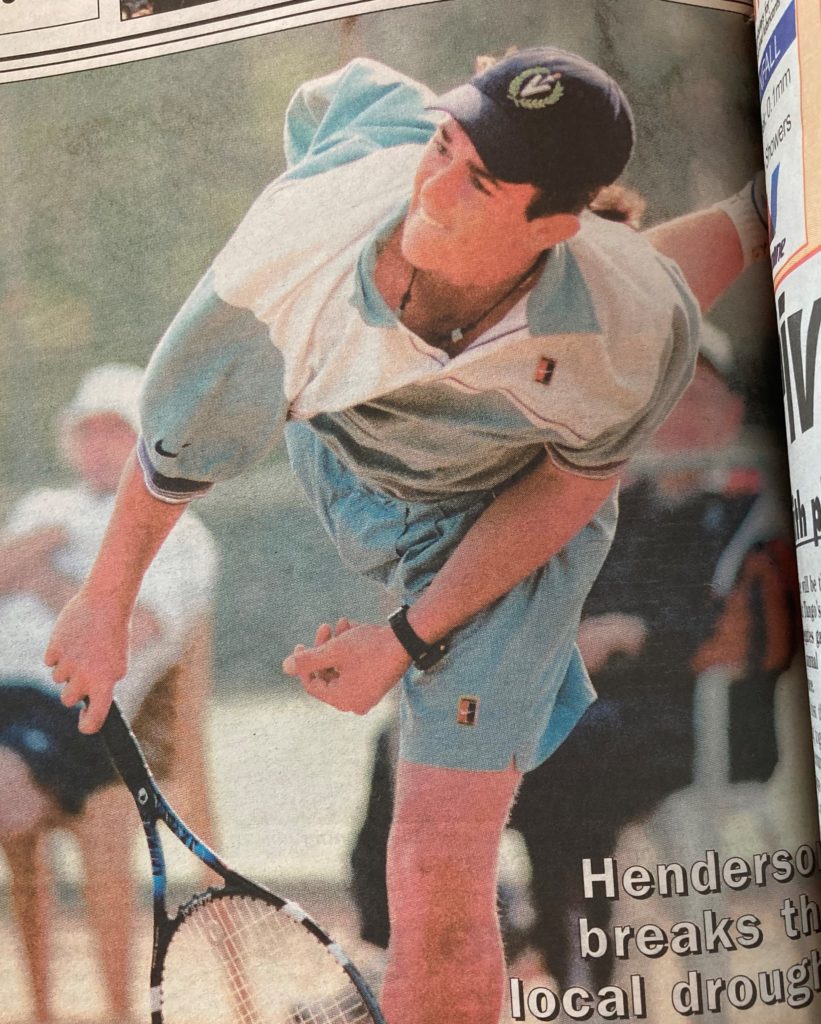
Mark Henderson (Griffith) 2 times Men’s Open Champion 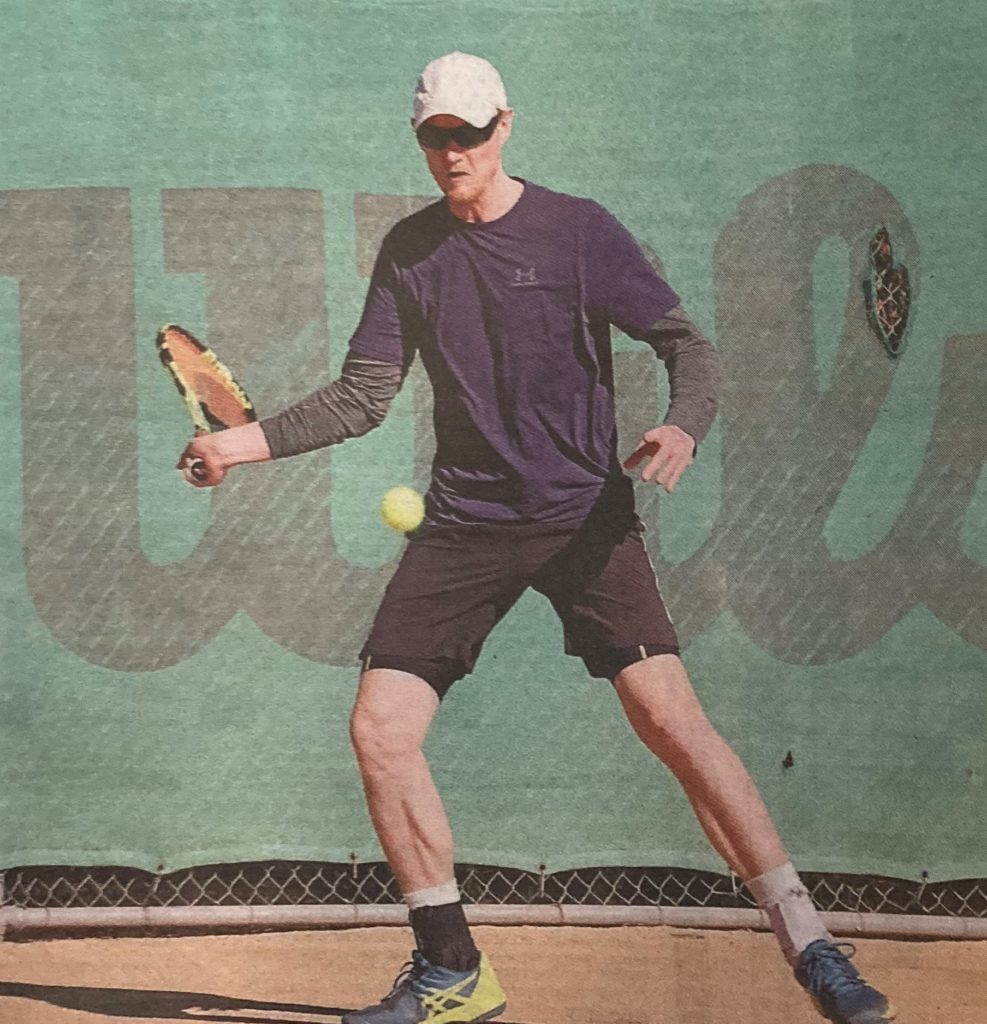
Danny Dossetor (Griffith) – 2004 Men’s Open Champion (and the rest)
2002 was a complete reversal of the previous year according to local Tom Condon. “The people who starred last year were blown away by the newcomers.” This covered all grades. Brenda Foster (Wagga) who won the World Vets Championships last year won the triple crown. She won again the next year beating Jennifer Wojciechowska (U17 champ) “in a masterful display of controlled tennis,” interestingly “Wojciechowska’s style was of great interest the onlookers, in that not only did she drive with a forehand on either side, but even served with either hand.” Adam Flemming (Bendigo) who was a “self-confessed tennis bum” was dragged along by his girlfriend, won the men’s singles. Conspicuous by his absence was Bendigo coach Terry Smith.
Danny Dossetor started his run of singles championships in 2004. He won the singles, then with his sister Angela won the mixed, and his brother Jason, came runner-up in a close doubles final 7-5, 7-6.
In 2006 despite Danny Dossetor having the flu and “not doing too well actually,” won the singles, doubles with his brother and runner-up in the mixed. The Griffith Club boasted ten out of sixteen participants in the open finals that year. Peta Forsyth (Wagga) won the women’s singles again.

Peta Forsyth (Wagga) 2006 Women’s Open Champion 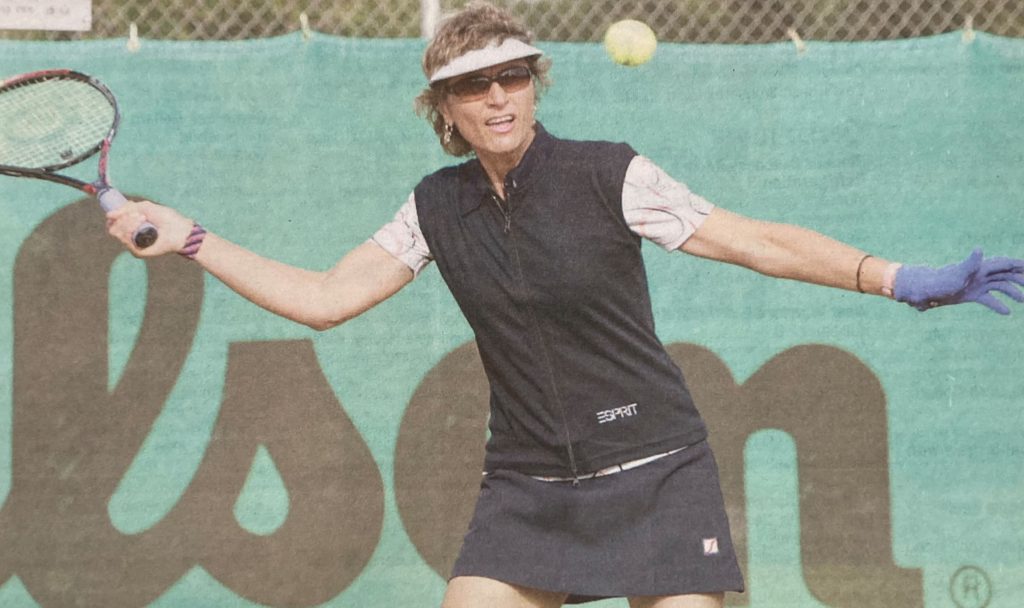
Brenda Foster (Wagga) 2 times Women’s Open Chanmpion
The “family” events continued to create a great atmosphere at the Jack Shannon courts. However Tom Condon did not compete – probably for the first time since 1945 – but his children and grandchildren did.
In a HUGE compliment to Griffith, renowned Sydney coach Mark Southwood compared the quality of the clay courts at the Jack Shannon courts to some of the best in Europe. “These clay courts are as good as I’ve ever seen. It’s staggering the effort that has gone into the courts.”
In 2008 the new coach in Griffith, Chris Letcher ended Danny’s winning streak by defeating him in three hard fought sets 6-2, 6-7, 6-4. Both players showing the class that got them to the final.
And in 2009 there were a record forty entries in the open men’s singles, and >100 entries in family events. Geelong’s Justin Robinson defeated Danny Dossetor on the third attempt at winning the open men’s title.
2010s
2010 men’s singles were supposed to be the most evenly contested in years. “Top men’s seed Nicholas Kyrgios had strolled through the early rounds to make his way to the semi-finals, dropping only six games in the process.” He was then defeated by the eventual winner, unseeded Brandon Vescio of Albury 7-6, 6-2. Vescio had “a five-year break from tennis as he wanted to live like a normal teenager.”
The men’s open in 2011 was like reading a who’s who of elite country players. Danny Dossetor played a mouth-watering final against Junior Davis Cup representative Joey Swaysland. “It was Dossetor’s ability to use the drop shot, sometimes from well back in the court, forcing Swaysland out of position and open to a passing shot or lob” that made the difference. The two left-handers Sophie Vickers (Bendigo) and Peta Forsyth (Wagga) both tried to hit clean winners to win the open women’s title. Vickers made less mistakes and ran out the easy winner.
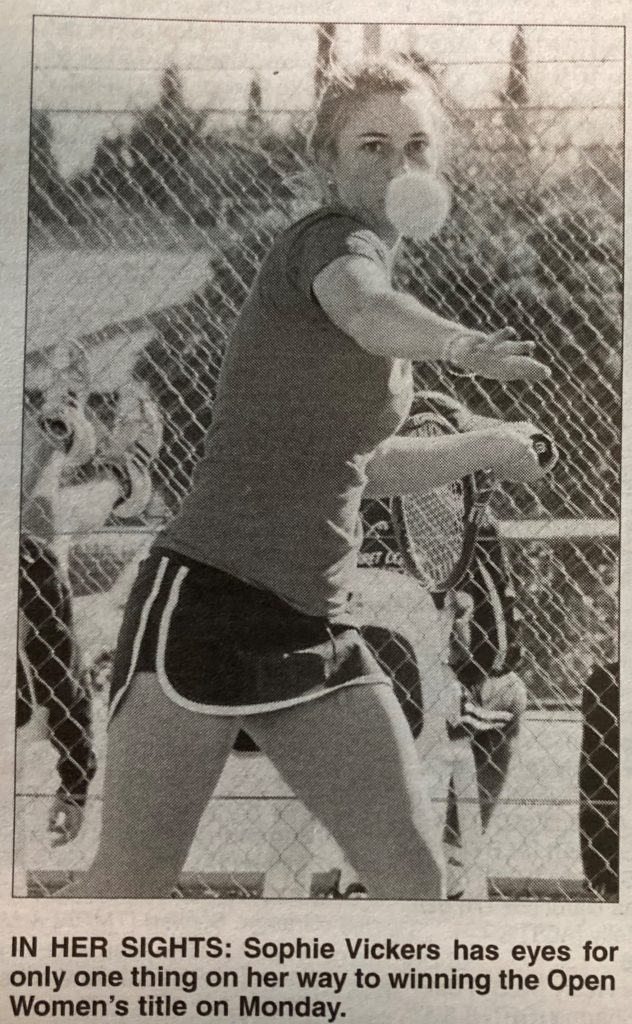
Sophie Vickers (Bendigo) – 2011 Open Women’s Champion 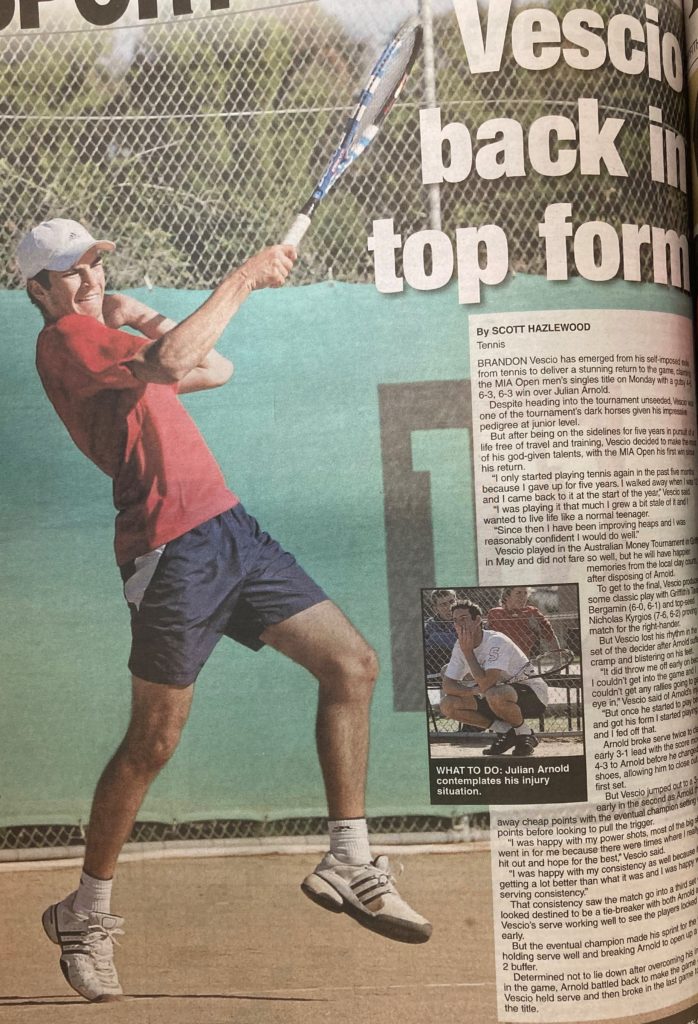
Brandon Vescio (Albury) – 2010 Open Men’s Champion
Danny Dossetor won his sixth crown to make him as successful as Griffith’s Bill Mackay (1940-50s), and Steve Maloney (1980s). He defeated Jade Culph of Albury. Griffith’s Blake and Maddison Gregor won a close open mixed final against Andrew Noad and Megan Polkinghorne also of Griffith. Noad and Polkinghorne reversed the result the following year.
In 2014 Blake Gregor at 21 years of age said “I played in the tournament every single year for fifteen years and now I’ve finally made it to the last round.” However with a marathon semi-final the day before, he was unable to win the last match of the tournament. Aiden Fitzgerald from Victoria who had also been coming to the MIA tournament for a good ten years or more also won the doubles against Griffith pairing of Gregor and Tavis Bergman. Kaitlin Staines (Wagga) won the women’s singles.

Danny Dossetor (Griffith) – 9 times Open Men’s Champion 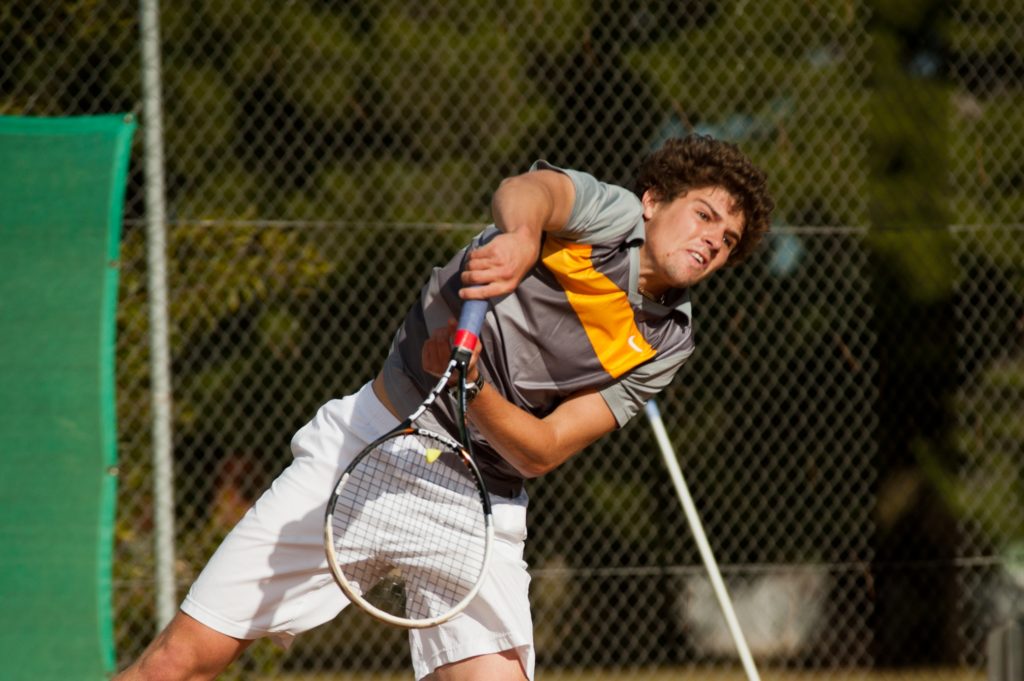
Blake Gregor (Griffith) – 2014 Open Men’s Finalist
The courts were described as very similar to French Open clay, and there are virtually no clay courts left in Australia. The social events help create a family friendly atmosphere that the MIA Open promotes. In 2016 there was a large amount of players returning, which is a testament to a unique tournament provided by tournament director Steve Longworth who runs tournaments all around the world. James O’Brien made it two in a row, and he also collected the triple crown that year. Tavis Bergamin who hadn’t played for almost a year removed several seeded player before going down in the semi-final.
Danny Dossetor won his seventh men’s title the next year (equalling Rex Sara from the 1920-30s) defeating former pupil Andrew Watterson (Queensland). They then joined forces and won the doubles against Griffith’s Tavis Bergamin and Ben Mahlknecht. Tallulah Farrow from the ACT went on to win two of her three open events.
2018 and 2019 saw Danny Dossetor defeat Jamieson Nathan in the men’s singles but lose to him in the doubles with partners Brady Clifford and then Joel Gordon. Katlin Staines won the triple crown in 2019.
Thus, Danny Dossetor having won nine open men’s singles titles must now rank as Griffith’s greatest men’s player ever.
And, of course, Lynette Andreazza must rightfully claim the ‘greatest ever’ mantle in the women’s arena, with multiple titles in all open events to her credit.
Some photo galleries from the 2010s:
2011 MIA Open
2012 MIA Open
2013 MIA Open
2014 MIA Open
2019 MIA Open
